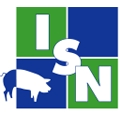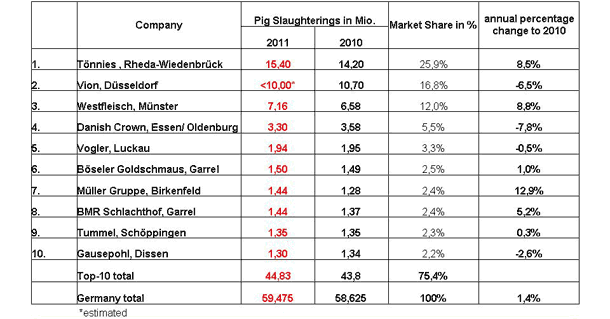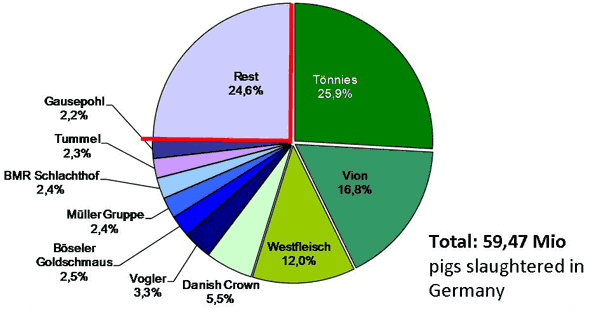 Over the past years, the german pig slaughterers knew only one motto: increasing the slaughter capacity. Now a phase of consolidation seems to be started.
Over the past years, the german pig slaughterers knew only one motto: increasing the slaughter capacity. Now a phase of consolidation seems to be started.
Light and shadow dominated the year for the four largest slaughter companies. Some had to sacrifice much, now being in the middle of the consolidation process; others were able to realise further stages of growth.


The pigs-mature-for-slaughter market still is highly concentrated in Germany. The Top-10 companies are almost constantly carrying out 75 % of all pig slaughters. If you look behind the figures, you’ll find the true dimension of the industry. Out of the ten largest pig slaughter companies, the Top 4 alone make it to a market share of more than 60 percent. 15 percent of the market are covered by the six following companies.
A number of Top 10 companies stated towards the ISN Interessengemeinschaft der Schweinehalter Deutschlands e.V. that they see future saving potential in optimizing the production processes above all, as for instance with regard to energy- and water consumption.

Top 4 in detail:
Toennies: With An Eye to China As A Growth Markt
Toennies continues to be top of the class, with about 15.4 million pigs slaughtered last year. So in 2011, the biggest german slaughter company still has been clearly expanding, increasing their number of slaughters by 1.2 million pigs.
Toennies has been holding a 50 % export share for a few years. The markets abroad are continuously important for Toennies. Traditionally, Toennies is particularly good in trade with Russia. But now the Asian markets are being focused on ever more. Toennies announced, for instance, to plan investments in cutting companies in China.
VION and Westfleisch Presenting Their Own Animal-Welfare Labels
In 2011, the distance between VION and the No. 1 grew again. Vion lost a big part of their market share. According to ISN estimations, Vion slaughtered less than 10 million pigs last year in Germany. Exact figures were not given by the company. Vion intend to concentrate more on the home markets in future instead of growing via exports. Accordingly, Vion try to exploit new market segments: Together with the German Humane Society (an animal welfare society) and others, a kind of “animal-welfare label” is being developed which is intended to guarantee the customer higher standards in animal husbandry.
Westfleisch were able to increase their number of slaughters. Growth to up to 7.16 million pigs was made possible in particular by increased export rates. Similar to the Toennies figures, Westfleisch’s export share is around 50 %. Growth proved to be particularly strong in the Asian markets such as Hongkong, China and South Korea. Just like Vion, Westfleisch exploited a new market segment in 2011 with the label “Aktion Tierwohl” (a campaign for animal welfare). According to information given by Westfleisch, 120 companies counting an annual 410,000 pigs are currently taking part in this campaign. But to the knowledge of ISN, those labelled products are mostly produced for exports to foreign markets.
At the beginning of 2011, the D&S Fleisch slaughter company was taken over by the Danish group of companies Danish Crown. But after the change of ownership, the number of slaughters could not be maintained because, amongst others, the Cappeln site has been closed, at least temporarily, since August 2011. Over the past year, about 3.3 million pigs were slaughtered, which means 8 % less than in 2010.
Ranks 5 To 10 On The Move – Medium-sized Businesses Show Mixed Results

Light and shadow also prevail in the lower part of the table. Some of the companies were able to expand their position, others went down in the ISN slaughterhouse ranking.
Vogler slaughtered 1.94 million pigs in total at their premises at Steine, Bremen and Laatzen. This way, the previous year value was achieved again. Vogler, too, are exporting more than half of their products to countries all over the world.
With 1.5 million slaughters in 2011, Boeseler Goldschmaus (Garrel) also remained on the previous-year level. Expanding their capacities is not scheduled for 2012.
A neck-and-neck race is run for rank #7 among the Mueller Group (South Germany) with their slaughterhouses at Ulm, Bayreuth and Birkenfeld and the BMR slaughter company at Garrel. As a result of incrased slaughter capacities at Ulm, the Mueller Group had 1.44 million pigs slaughtered in 2011, which was about 13 % more slaughters than in 2010.
An increase of about 5 % was reported by the BMR slaughter company, where 1.44 million pigs were slaughtered in 2011. BMR as well does not primarily strive for further growth but for reducing the running costs.
The fact that Tummel, a company from Westphalian Schoeppingen, still is found in the official statistics must be attributed to the cartel office’s intervention. The cartel office had interdicted the taking over of Tummel by Toennies at the end of 2011. At the Tummel premises, a steady number of 1.35 million pigs was slaughtered last year.
Gausepohl (Dissen) have been on a consolidation course last year, going down in the ranking list by a few ranks. By their own account, Gausepohl slaughtered 1.3 million pigs in 2011 (- 2.6 %). This slight decrease was, amongst other issues, attributed to the closing down of the Chemnitz premises which again was justified by too high energy- and disposal costs as well as by too high veterinary fees.
ISN: Keeping A Watchful Eye On The Balance Of Forces
Reduction of costs at the slaughter companies? “Honi soit qui mal y pense.” Be it on designing the reducing masks or on classifications, in view of internal prices or, as most recently, on the unspeakable prolongation of the term of payment at Vion: The ISN will continue to keep a watchful eye on things. Last year’s attempted takeover of Tummel by Toennies showed clearly that the business leader is targeting in particular at expanding its market share.
“Be sure that we will go on watching the market very closely – and will intervene if need be, as we did last year. The balance of power between the red and green sides, which is unequal anyway, must not be further destabilised! We need strong market partners, but there is a distinct difference between what is market strength and what is market power!“ emphasizes ISN CEO Dr Torsten Staack.
March 30, 2012 - ISN-Interessengemeinschaft der Schweinehalter Deutschlands e.V.


